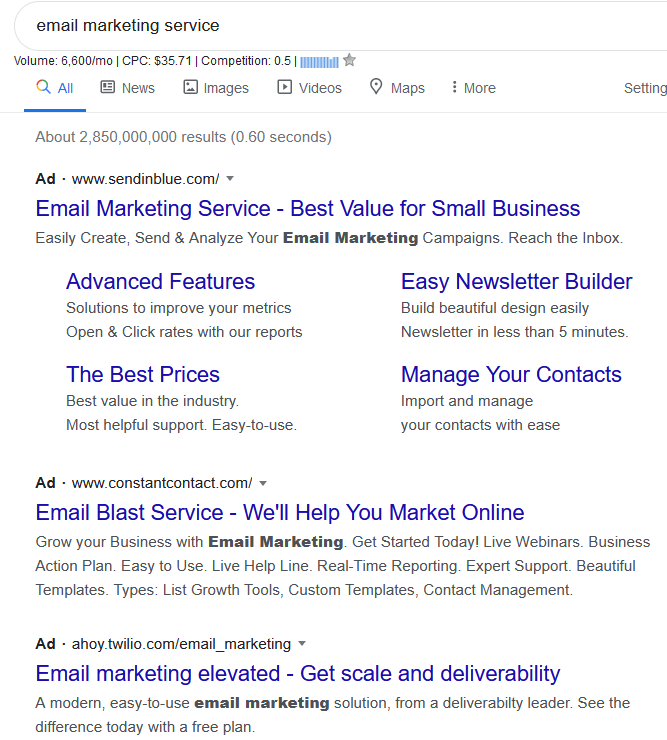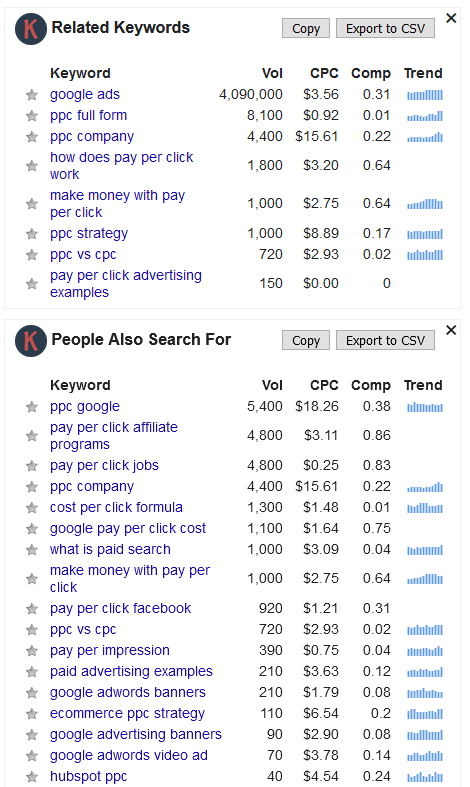Even for a small business, digital marketing is a complex beast. There are so many choices that brands can inadvertently sabotage their own efforts.
Two of the main marketing strategies you'll hear about as a growing business are search engine optimization (SEO) and pay-per-click advertising (PPC). Here we'll talk about what each one does and how to know which one you should be focusing on.
The fundamentals of PPC
Pay-per-click advertising, or PPC, involves placing ads in prominent places—like search engine results, social media platforms, and directly on other people's websites. The advertiser—that's you—pays a set amount each time their ad is clicked. (That amount is determined by factors such as the popularity and competition score of the chosen keywords.)
Google Ads is the world's biggest provider of PPC advertising. When you perform a search on Google, you might notice that the top few results sometimes have an "Ad" tag. That's how you know you're looking at a PPC ad.

PPC has a lot of benefits for small businesses:
You can instantly tap into and reach a potential global audience of millions of people. You almost certainly can't get that through SEO—at least not quickly.
You can target local keywords for your specific geographical location (e.g., "Italian restaurant in Scranton"). People love to support small, local businesses, and a good chunk of searches have a local intent.
They tend to have higher conversion rates (meaning the people who click end up using your product or service). This is because you can target your PPC ads towards particular search terms that qualified leads are likely to use.
Of course, it's expensive. You won't pay for your ad until you get those clicks, but it can be challenging to target high-volume keywords on a limited budget. And since you may not get it perfectly right and see a good return on ad spend (ROAS) the first time, learning to do PPC well through trial and error can be an expensive mistake.
If you decide to go the PPC route, read about how to increase your advertising ROI with Google Ads and Zapier. You might also try Google Customer Match and Google lead form extensions, which can both help ensure you're making the most of your ads.
General ads vs. retargeted ads
General ads target cold traffic: their goal is to bring people to your website, social media page, or landing page for the first time. They're generally easier to implement and require a simpler keyword strategy. You're using general tendencies, preferences, and online habits to target people. For example, a local nail salon's PPC ad might target women between 18 and 35 within their region who are searching online for nail polish brands.
Retargeted ads, on the other hand, are used when a visitor comes to your website but leaves before buying or signing up. These kinds of visitors are known as "warm leads": since they were interested enough to check out your website, retargeting them can reignite their interest and close the sale. For small businesses on limited budgets, retargeting can give you more bang for your buck since you know you're focusing on people with an interest in what you're selling.
What you need to run a successful PPC campaign
There's no magic formula for PPC success, but here are a few tips I've found that have worked for my clients.
Choose high-volume, low-competition keywords. The Keywords Everywhere plugin is an awesome tool that can help you find keyword ideas if you're running Google Search ads. Choose keywords that have a high search volume (1,000+ per month) and a low competition score (which is rated on a scale from 0 to 1).

Be thoughtful about your copy. Since you only have a short space in which to get your message across, every word needs to count. Tap into emotions, use a compelling call to action, and ensure your ad copy addresses the customer pain points you're seeking to solve.
Don't forget about the rest of your funnel. Your ad needs to lead to a smooth sales funnel process—otherwise, your clicks won't turn into conversions. Here's how I do it for my Affiliate Lab course: the ad invites people to sign up for a free webinar. Since this is a low barrier to entry, it gets a high conversion rate. Once they're on my mailing list, I can send them access to the free webinar and start to nudge them toward registering for the paid course. People love free stuff, and it doesn't have to cost you a fortune to offer it.
Once your campaign is launched, monitor it closely. Run A/B tests, and track your metrics. You can then assess what works and what doesn't, and update your campaigns accordingly.
The fundamentals of SEO
Search engine optimization (SEO) is about growing traffic to your site by people searching, seeing your site as a result, and clicking it. SEO involves a whole series of both big steps and tiny tweaks that can get your pages to rank. It includes everything from posting regular long-form content on your blog to using meta descriptions and optimizing your link anchor text.
Here are 6 Google ranking factors you can actually do something about. Once you've gone through that list, take a look at how you can get SEO rich snippets for your small business.
To maximize your SEO campaign strategy, you'll need to understand search intent—the reason why someone is searching for something. Do they have a question they want an answer to? Are they looking to buy something? Are they browsing? Are they trying to get to a specific site? Whenever you're creating content, you should be thinking about who's searching for it—and why.
In addition to creating content that people are searching for, you can also boost your content's visibility by having other, respected websites link to your content. The best two ways to do that:
Write guest posts for other websites in exchange for a link back to yours. This also helps you establish credibility and reach a new audience through different channels. I've seen businesses of all sizes supercharge their online reach by running guest posting campaigns.
Write genuinely useful and actionable content that people will want to share.
Ultimately, SEO is all about understanding what your audience wants, providing it, and making it easy for them to find it when they search.
SEO is essential—but it's also a long game
When's the last time you clicked on a link in Google that wasn't on the first page? It's rare, right? That's exactly why it's so important to invest resources in optimizing your website for search.
But SEO success doesn't come overnight. It's the result of a sustained effort over a period of time. There are no shortcuts—if you try to find them, you'll probably get a Google penalty, which is the opposite of the point.
According to Ahrefs, sites that rank in Google's top 10 are over two years old on average. The average age of a #1 search result? Just under three years.
How to use SEO and PPC together
To summarize:
PPC allows for rapid growth, but it's expensive.
SEO offers the potential for theoretically unlimited organic traffic, but it takes a while.
So you might not be surprised to hear that, when people ask me whether PPC or SEO is best, I always tell them: both. I wouldn't choose one over the other. Instead, use them together to acquire new customers quickly while also investing in the long-term health and success of your site. You can even use PPC to retarget organic SEO traffic when those visitors engage with your site but don't convert.
The trick is in understanding your goals and making sure you choose the right channels and strategies to meet them. Take your time, learn how to do each one well, and assess your results as you go along, so each campaign is better than the next. Reach out to me at diggitymarketing.comif you want to chat more!
This was a guest post from Matt Diggity, founder and CEO of Diggity Marketing. Want to see your work on the Zapier blog? Check out our guidelines, and get in touch.





